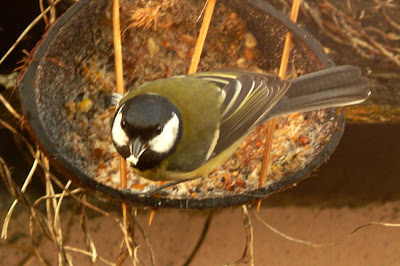
 male
maleWe have 4 male Blackcaps in the garden at the moment. Although originally classified as a migrant bird, there is a small population of Blackcaps which are now resident in the SW of Ireland.
During the cold winter 2009/2010 we had a female visiting the birdtable. She was a very feisty lady and even the House Sparrows and Chaffinches were put in their place whenever they came too close to where she was feeding on the seed and home made peanutcake. The first male which appeared us was a very shy character however and very polite too, whenever other hungry species would come close.
This all changed when another three Blackcaps (all males) made this garden their local diner.
 female, March 2010.
female, March 2010.


Blackcap and Greenfinch.

The Blackcap is feeding on one of the many peanutcake pots and trays, while the Greenfinch prefers the mixed seeds.
I really hope that there is one or more female Blackcaps around as I'd love to see them breed in my area.
One of my 4 males should be able to sire offspring, don't you think?
It is weird that their total keeps growing now that the worst of this early winter cold weather has past. Wonder where they had been hanging around? And will I get any more? If so, can I have a female perhaps?
Mind you, they make great subjects for photos, I think.
Although many of the heavier birds try to steal nuts from the feeder, the Blackcap is the only one which is able to cling on and feed on the peanuts inside the feeder.
 Blackcap and Siskin.
Blackcap and Siskin.



















